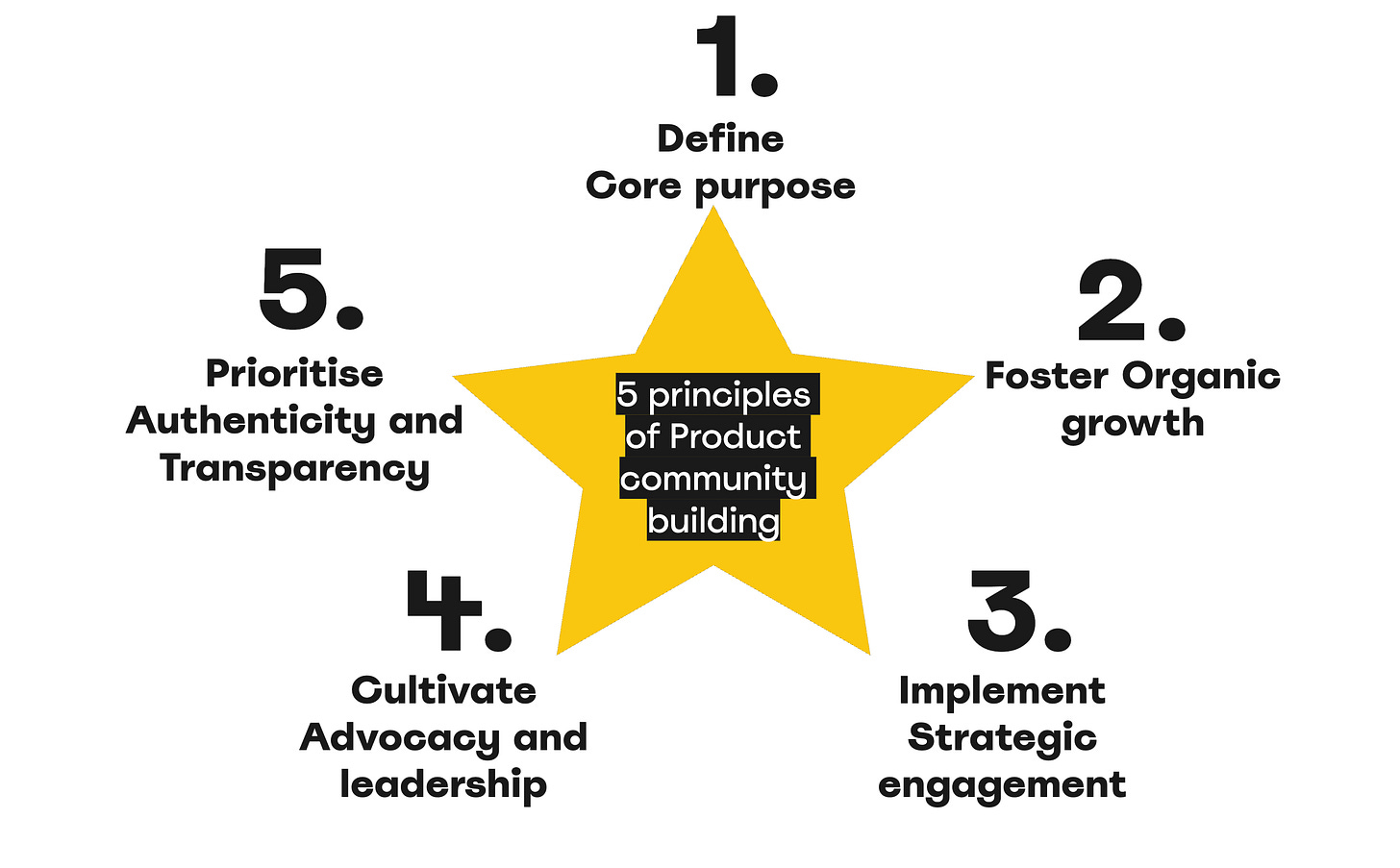How to Build a Product Community from Scratch: A Practical Guide
Best principles of community building from companies like Miro, Canva, Butter. Practical guide for anyone looking to build their product community from the ground up.
Creating a thriving community around a product from scratch is no easy task, but with the right approach and insights, it can become a rewarding journey. Drawing from the rich experiences shared by speakers in many episodes of the Community Unlocked podcast, we can distill a practical guide for anyone looking to build their product community from the ground up.
Introduction
Building a product community is not just about gathering users; it's about creating a vibrant ecosystem where members actively engage, share, and grow together.
The combined advice of our speakers offers a blueprint for nurturing such spaces.
But before moving into this, let's speak about what community is not.
What Community is Not
A Marketing Channel
"A community should not be seen merely as a marketing channel. It’s a space for genuine connections and support, not just for promoting products." - Helena Brandist
A Quick Fix for Engagement
"Building a community is not a quick fix for low engagement. It requires consistent effort and a genuine commitment to the members." - Milly Tamati
A Place for Self-Promotion
"A community is not a dumping ground for self-promotion. It's a space for meaningful interactions and mutual support." - Yana Belova
A One-Size-Fits-All Solution
"Communities are not one-size-fits-all. What works for one community might not work for another. Each community is unique and needs a tailored approach." - Yana Belova
A Passive Entity
"A community is not a passive entity. It needs active participation and engagement from both the members and the leaders to thrive." - Mila Jovicevic
Practical guide to build your product community
Step 1: Start with a Core Purpose
Identify Your Why
Understanding the core reason behind creating the community is essential. Is it to support users, gather feedback, or connect like-minded individuals? For example, Anamaria started with a simple goal to connect professionals, which organically grew into a community.
Always explain the 'why' behind your actions to foster a deeper connection within your community.
"Building a community is about understanding and clearly communicating your purpose. When people see the 'why' behind what you're doing, they are more likely to engage and contribute meaningfully." - Anamaria Dorgo.
Define Your Audience
Knowing who your community is for and tailoring your community's purpose to meet the needs and interests of this target group is crucial. This helps in creating a sense of belonging and purpose for the members.
“I like to compare building a community to building a product. You start by defining your audience and gaining a deep understanding of their behaviour and problems. From this understanding, you can determine the value you will bring to them.” - Elena Avramenko
Step 2: Foster Organic Growth
Create a Welcoming Space
Your platform should invite participation and make members feel at home. Facilitate easy interaction among members and ensure that the community is inclusive and supportive.
"From the start, I knew I didn’t want a community that was just a ghost town or a self-promotion drop. It had to be a place with depth of connection." - Milly Tamati
Encourage Member-Driven Initiatives
Allow members to take the lead on certain activities or discussions. This empowers them and fosters a sense of ownership, making the community more dynamic and engaging.
"It's important to let members lead initiatives. When people feel ownership, they are more likely to stay engaged and bring in new ideas." - Yana Belova
Step 3: Implement Strategic Engagement
Set Clear Objectives
While organic growth is vital, having clear goals for your community can guide its development. Determine what success looks like for your community. For instance, understanding the KPIs and objectives of the community helps in aligning efforts towards common goals.
Leverage Feedback Loops
Use member feedback to shape the community and your product. Butter, for instance, actively uses community insights to refine their offerings. Building products with community members together not only enhances the product but also strengthens community ties.
"Listening to your community and acting on their feedback is crucial. It makes members feel valued and helps you improve your product." - Helena Brandist
Step 4: Cultivate Advocacy and Leadership
Identify and Support Ambassadors
Recognise active members who can act as community leaders or ambassadors. Provide them with tools and recognition to foster their growth and the community's.
"We're building our core community team; I'm looking for five people in the community for a one-year assignment, and they are going to be my right hand, my support for community strategy brainstorm and make sure that we keep this space vibrant and valuable for everyone." - Anamaria Dorgo
Create Roles for Active Members: Anamaria's concept of 'shapers' within the Butter community underlines the importance of having roles for engaged members, enhancing their commitment and contribution.
The "shapers" concept refers to the core members who have significantly influenced the development and direction of the community. These individuals are not merely participants but play a crucial role in shaping the community's values, culture, and initiatives. Recognised for their contributions, shapers are integral to the community's evolution, actively involved in decision-making processes and often leading by example. Their engagement goes beyond mere participation, embodying a deeper commitment to the community's growth and success.
Step 5: Prioritise Authenticity and Transparency
Be Genuine
Your community should reflect the genuine values and mission of your product. Authenticity in communication and actions builds trust and loyalty.
"Authenticity is the cornerstone of a strong community. When members see that you're genuine, they're more likely to stay engaged." - Yana Belova
Transparent Communication
Keep your community informed about developments, challenges, and successes. This open line fosters a deeper connection with your members.
"Transparency is key. Keeping your community in the loop about both the highs and lows builds trust and strengthens your relationship with them." - Helena Brandist
5 Misconceptions of Building a Community
Communities Grow Themselves "Many believe that once you set up a community, it will grow on its own. In reality, it requires continuous nurturing and strategic engagement." - Helena Brandist
More Members Mean More Success "It's not about the number of members but the quality of engagement. A smaller, more active community can be far more valuable." - Milly Tamati
Mindaugas Petrutis on on the difference between a community and an audience.
Community Building Is Free "Effective community building requires resources, whether it's time, money, or tools. Investing in your community is crucial for its success." - Yana Belova
Communities Don’t Need Leadership "Without clear leadership, communities can become directionless. Strong leaders help guide the community and maintain its focus and purpose." - Anamaria Dorgo
Engagement Will Happen Naturally "You need to create opportunities for engagement. Events, discussions, and activities encourage members to interact and participate actively." - Max Pete
How to Internally Communicate the Value of Community
Demonstrate Tangible Benefits
Show how the community contributes to the company's goals, such as improving customer retention, gathering product feedback, or increasing brand loyalty.
Max Rothery on communicating the value of community cross-functionally.
Conclusion
Building a product community from scratch is an iterative and evolving process. It requires a balance of strategic planning and organic growth, fueled by genuine engagement and a clear understanding of your community's needs. By following these steps and remaining adaptable, you can cultivate a thriving product community that not only supports your product but also enriches the lives of its members.
"Community building is a journey of continuous learning and adaptation. The most successful communities are those that evolve with their members." - Milly Tamati
Remember, every community is unique, and what works for one may not work for another. Use these guidelines as a foundation, but don't be afraid to experiment and tailor your approach to fit the specific dynamics of your community
About Community Unlocked
Community Unlocked is an audio and video podcast where we,
and , have conversations with top-tier community leaders and growth experts. Our goal is to provide you with concrete and actionable advice to help you learn about launching, building, and growing your community.Subscribe to not miss out on any future episodes
🌟 Podcast Sponsorship Opportunity 🌟
We are thrilled to announce that Season 2 of our podcast is coming soon, and we are actively seeking sponsors for our upcoming episodes! This is a fantastic opportunity to showcase your brand to our engaged and growing audience.
If you're interested in collaborating with us, please reach out directly via LinkedIn - 🔗 Helena or Elena. We look forward to partnering with you to make this season even more exciting!
Let's create something amazing together!




